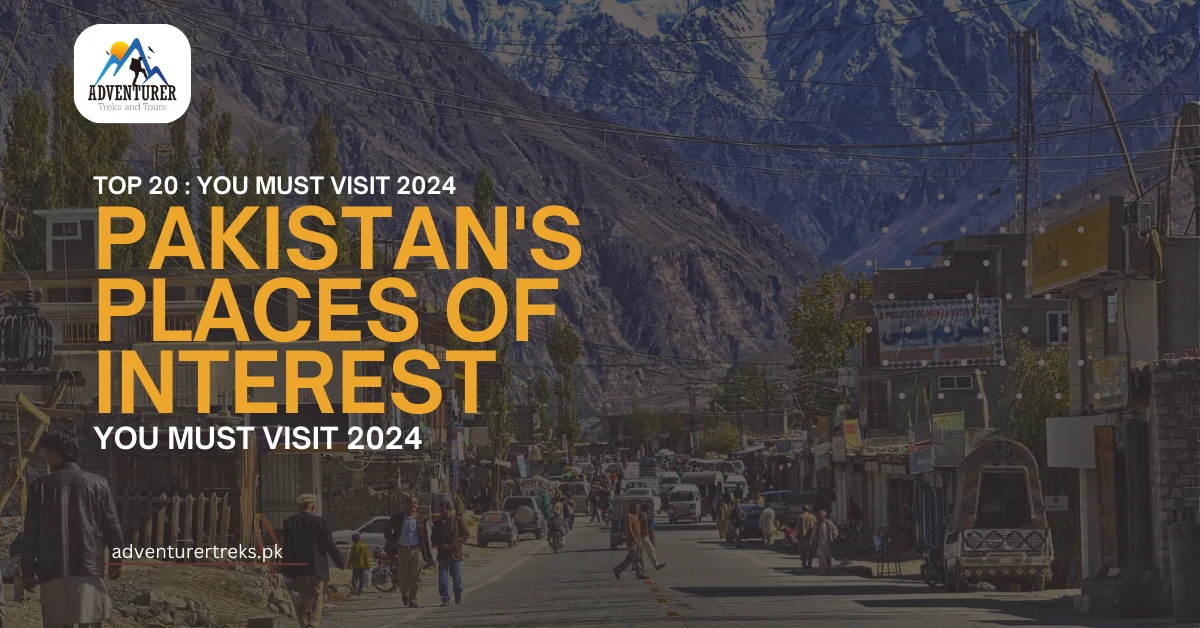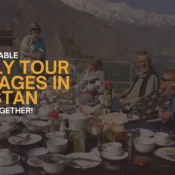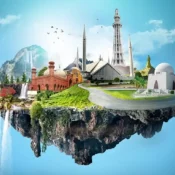Pakistan, also known as the “Land of the Pure,” is a country blessed with an incredible diversity of stunning natural scenery and rich cultural heritage. Located in South Asia, this diverse nation has long fascinated tourists and adventurers with its breathtaking places of interest, natural beauty, interesting past, and dynamic cultural legacy.
20 Most Pakistan’s Places of Interest
We set out on an adventure to discover Pakistan’s distinct and appealing beauty. In this article, we will share information about some of the most famous Pakistan’s places of interest for people who are planning on visiting Pakistan.
Swat Valley
While Pakistan offers many breathtaking locations, the beautiful valley in the Khyber Pakhtunkhwa region is truly mesmerizing. The mind-blowing green fields and forest, charming towns, and streams are so mesmerizing. Swat Valley is located northwest of Khyber Pakhtunkhwa province of Pakistan.
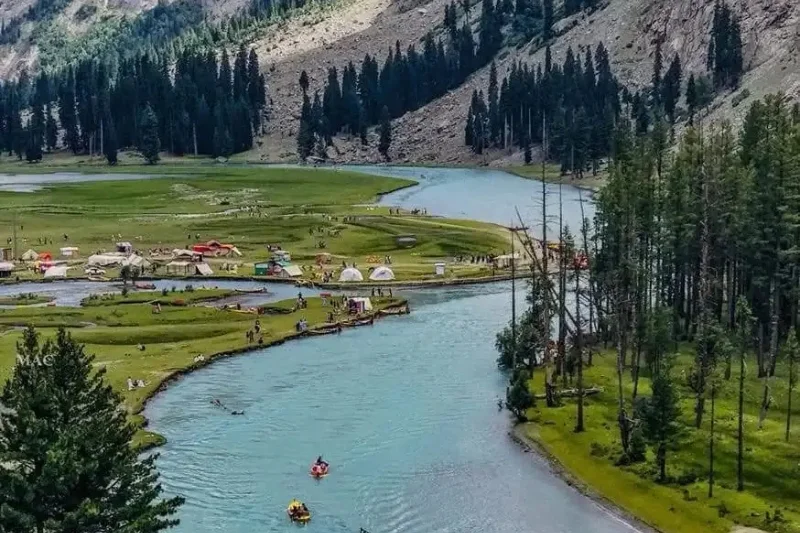
Pleasant and wet weather distinguishes Swat Valley from the whole country and attracts visitors from all around the world. One can reach Swat Valley through Islamabad, Rawalpindi, and Peshawar.
Additionally, visitors can partake in a variety of local activities like ice skating, skiing, zip line, hiking, and trekking. The Swat Valley is surely one of the places of interest in Pakistan due to its natural beauty.
Some of the popular tourist locations in Swat Valley are:
- Margazar
- Swat Museum
- White Place
Hunza Valley
The Hunza Valley is a mountainous valley in the northern part of the Gilgit-Baltistan region of Pakistan. Hunza is known as the Heaven on Earth. Thousands of travellers visit this region every year to explore the timeless beauty of Hunza.
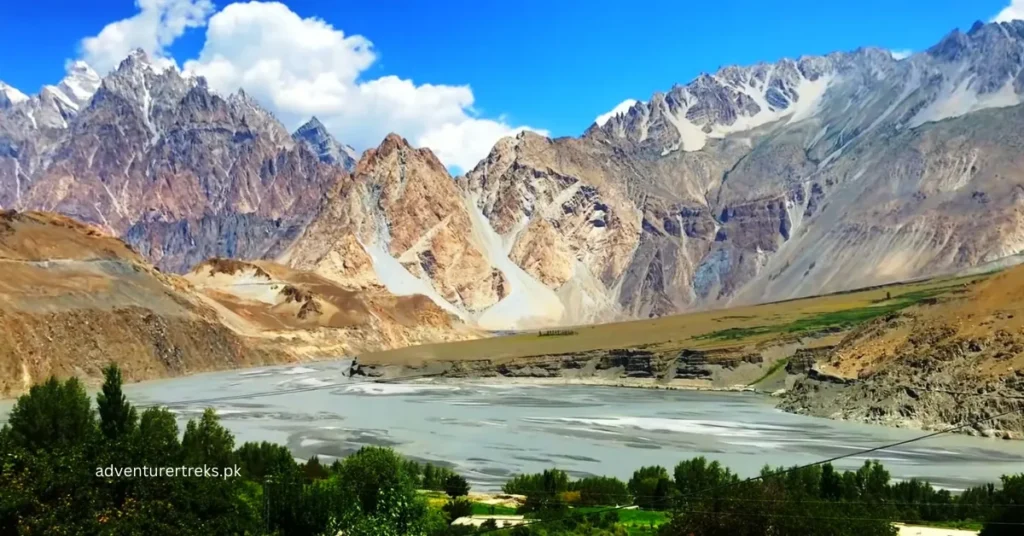
The most sought-after tourist destination in Pakistan, Hunza Valley has it all – majestic mountain ranges, stunning landscapes, ancient forts, rich culture, and delicious local food.
It can be reached by flying to Islamabad International Airport, renting a car, or taking public buses that depart Gilgit from Islamabad/Rawalpindi via the Karakoram highway. Additionally, there are several lakes close to Hunza, including Hassanabad Lake, Borith Lake, Shimshal Lakes, and Attabad Lake.
Some of the popular tourist spots in Hunza Valley are:
- Baltit Fort
- Altit Fort
- Attabad Lake
- Karimabad
- Passu Cones
Yarkhun Valley
The stunning Yarkhun Valley is situated in Khyber Pakhtunkhwa, Pakistan, in the Chitral province. It is bordered by Afghanistan to the west and Tajikistan to the north. The valley is known for its stunning scenery, towering mountains, lush green meadows, and crystal-clear streams.
Yarkhun Valley is a popular destination for trekkers, campers, and wildlife enthusiasts. The valley is home to a variety of animals, including snow leopards and Himalayan tahr.
Some of the important locations in the Yarkhun Valley are:
- Mastuj
- Borith Lake
- Broghil Pass
- Yarkhun River
The best way to get to Yarkhun Valley is by plane from Islamabad to Chitral. The flight takes about 1 hour and 30 minutes. From Chitral, you can take a taxi or jeep to Yarkhun Valley. The stunning scenery of Yarkhun Valley makes it to the list of Pakistan’s places of interest for tourism.
Phander Lake
Phander Lake is the largest lake in the Phander Valley, and it has the most romantic and charming colours, which attract most of the tourists in this area. It is situated in Koh-i-Ghizer in Gupis-Yasin District. It is the main source of fresh water in Phander Valley.
Phander Lake is more than just a lake; it is a destination that offers a unique and memorable experience for visitors. The lake is a perfect example of the diverse and stunning landscape of Pakistan, with its emerald green water, lush green meadows, and snow-capped peaks.
The lake is also a place of historical and ecological importance, as it is a habitat for various fish species and a source of irrigation for the local farmers.
Phandar’s crystal blue lake is home to trout fish and provides an amazing view. In June and July, the weather of the valley remains very pleasant and is the best-suited time to visit. It is simple to reach Phandar Valley from both the Gilgit and Chitral sides. Phander Valley may be reached within five to six hours of Gilgit.
Broghil Valley
One of Pakistan’s most difficult-to-reach tourist spots is the Broghil Valley in Chitral due to its geography. But it doesn’t imply there aren’t any tourists in this area. Broghil Valley is becoming more and more popular among both domestic and foreign tourists despite its location.
The Broghil Valley is located in a remote mountainous area about 250 kilometres from Chitral City. It shares borders with the stunning Gilgit-Baltistan and the ancient Wakhan Corridor, a dangerous strip of land that divides Tajikistan from Pakistan and stretches from Afghanistan to China.
The Broghil Valley begins at Lashkargaz, a charming little village in Chitral that is well-known for hosting an annual traditional polo tournament. Taking a flight with Pakistan International Airlines to the little domestic airport in Chitral is the most convenient method to get to Broghil Valley in Chitral.
These are a few of the most interesting sites in the captivating Broghil Valley.
- Karambar Lake
- Broghil Pass
- Darkot Pass:
Although Broghil Valley is difficult to reach, the natural beauty of the valley is worth it. This location is surely among Pakistan’s places of interest.
Lahore
The capital of Punjab province, Lahore, is the second-biggest city in Pakistan after Karachi. It is frequently referred to as the nation’s cultural capital. Lahore is famous for the variety of food it can offer to its tourists, no matter what time of the day it is.
The people of Lahore are friendly and hospitable. The city has seen centuries of growth in literature, music, art, philosophy, and culture. There are lots of tourist attractions in Lahore.
The Lahore Fort, Badshahi Mosque, and Gurdwara are examples of the Mughal and Sikh heritage; the Mall is flanked by British Raj colonial-gothic architecture; and the suburbs of Gulberg and Defence are home to luxurious residences and trendy shopping areas.
You can easily reach Lahore from any area of Pakistan, as there are plenty of options available. If you visit Pakistan and don’t explore Lahore, you are at a loss. The food, architecture, and cultural heritage of Lahore make it among the top places of interest in Pakistan.
Some of the popular tourist destinations in Lahore are:
- Minar-e-Pakistan
- Lahore Fort
- Badshahi Mosque
Hingol National Park
One of Pakistan’s biggest national parks, Hingol, is situated in the Makran coastal region.
Hingol National Park is situated approximately 190 kilometres from Karachi. The park is surrounded by a desolate mountain range to the south, a thick forest to the north, and a tributary of the Hangul River, which is home to thousands of migratory birds and marsh crocodiles.
Since the Makran Coastal Highway was completed in 2004, people from all over the world have been drawn to the park because of its unusual rock formations.
At least 35 mammal species, 65 amphibian and reptile species, and 185 bird species are known to be present in Hingol National Park. Wild Sindh ibex, Balochistan urial, and Chinkara all have excellent habitats in the park.
There are plenty of mud volcanoes ranging from 800 to 1500 feet in Hingol National Park. Every year, Hingol National Park draws large numbers of visitors from all parts of the world, locally and from all parts of the world, due to its distinct features.
Kalash Valleys
The Chitral District in northern Pakistan contains valleys known as the Kalasha Valleys. The Hindu Kush mountain range surrounds the valleys.
The Kalasha people live in the remote Kalash Valley, sometimes called Kalasha Valley, because it is made up of three different valleys deep in the mountains near the boundary between Pakistan and Afghanistan.
The Kalasha are said to be descended from Alexander the Great’s army, setting them apart from the rest of Pakistan’s population.
Before leaving for the trip, choose which of the three Kalash Valleys you would want to see:
- Bumburet
- Rumboor
- Birir
You begin your journey to the Kalasha Valleys at Chitral. You may take public transportation to any valley you like to explore, and the route is usually the same. Kalasha Dur Museum, which is locally run, is an excellent place to begin learning.
Before going into the valleys, you can get all the background knowledge you require at the visually appealing cultural museum in Bumburet Valley. If you love adventure, you should visit Kalash Valleys, which will make you fall in love with the beauty of the surroundings. Kalash Valley is among the places of interest in Pakistan.
Deosai Plains National Park
Location and Size
Southeast of Skardu is home to Deosai National Park. It covers an area of 3,58,400 hectares. Deosai National Park is situated in the Himalayan and Karakorum-Pamir highlands, where two biogeographical provinces meet.
Establishment and Purpose
In 1993, authorities made it a national park with the main goal of safeguarding and preserving the Himalayan Brown Bear (Ursus arctos Isabellinus). The park hosts a wide range of animals, including Tibetan wolves, Himalayan ibex, Tibetan red foxes, and golden marmots.
Biodiversity Hotspot
Moreover, it is a member of the Conservation International Himalayan Biodiversity Hotspot. Snow trout grow to huge sizes in the rivers of the Deosai plateau.
Significance for Birds and Plants
The park serves as a significant breeding and resting area for migratory and resident birds of international importance, and it lies within Birdlife International’s Western Himalaya Endemic Bird Area. Numerous types of aromatic and medicinal plants thrive in Deosai’s flora.
Springtime Beauty
In the spring season, you can see various types of butterflies. Deosai National Park is a must-visit tourist spot. It is also among the top places of interest in Pakistan.
Gorakh Hills
Gorakh Hill is Pakistan’s hill station located in Sindh. This Hill Station, situated 94 kilometres away from Dadu at an elevation of around 6,000 feet above sea level, offers breathtaking vistas and sunsets. Regarding the origins and history of the hill station, various viewpoints have been expressed.
It is reported that Gorakhnath, a medieval Hindu saint, spent a great deal of time wandering around the area and its hills. The nightlife at Gorakh Hill Station is well-known, particularly the Bonfire setup.
It is very attractive to nature lovers owing to its temperate weather and beautiful surroundings. Situated on the hill is a brand-new guest house. Tourists can arrange their transportation from Sehwan Sharif to the hill station.
A large number of visitors, mostly from Sindh and notably from Karachi, travel to the hill station. Even though the roads are not accessible and there is hardly any cell service, Gorakh Hill Station now has access to both water and electricity.
Shimshal Valley
Nestled deep in the Karakoram, Shimshal Valley is home to what may be the most dangerous road in Pakistan, making it one of the country’s most exciting travel destinations.
Relatively few people visit Shimshal because of its remote, inaccessible location, making it both famous and isolated at the same time. Locals living in the north are well aware of the valley’s beauty and danger, while most Pakistanis living in the country’s south are unaware of Shimshal.
If you love to test your limits and are looking for adventurous treks, Shimshal Valley is the right place for you. The valley is not crowded, and you can take a break from your busy routine and relax in the calm surroundings.
Shimshal Valley is accessible by bus or public transport from Aliabad Hunza. This area offers several hikes, all with different lengths and degrees of difficulty, and all of them are breathtaking.
There are enormous glaciers, towering mountains, and frozen waterfalls in the valley. Anything more than moderate difficulty should be done with a guide, the right gear, and some experience. Shimshal Valley, due to its calm and serene surroundings, is among Pakistan’s places of interest.
Shah Jahan Mosque
The Jamia Masjid of Thatta is another name for the Shah Jahan Mosque. It is a 17th-century structure that houses Thatta’s central mosque. Shah Jahan, the Mughal emperor, constructed the mosque during his rule and gave it to the city as a sign of appreciation.
The mosque is renowned for its geometric brickwork, a stylistic feature uncommon in mosques from the Mughal era. It is thought to contain the most intricate tilework exhibit in South Asia.
The mosque was finished in under three years, in 1647, after work began in 1644. Mughal architecture is distinguished by its grandeur, beauty, and symmetry, and the Shah Jahan Mosque is a stunning example of this style.
It has the most number of domes in Pakistan. Six enormous domes and the remaining smaller ones. Interestingly, it does not have a single minaret and features 33 arches. There are five entrances. Furthermore, the mosque can accommodate around 20,000 people at one time.
The mosque’s unique layout is intended to enhance the noise levels. If you love art and history, Shah Jahan Mosque is Pakistan’s place of interest for you.
Fairy Meadows
The world’s ninth-biggest mountain, Nanga Parbat, is situated in the Diamer District of the Gilgit-Baltistan area of Pakistan. Fairy Meadows, the centre of North Pakistan, is well-known for its breathtaking, lush green plateaus.
Situated 3,300 meters (10,826 feet) above sea level, Fairy Meadows is a broad grassy meadow encircled by lush alpine forest. The meadow receives its water supply from a glacier formed by the Nanga Parbat, which is the second-highest mountain in Pakistan after K2 and the ninth-highest mountain in the world.
This is a truly stunning location, made even more amazing by the adventurous route one must travel to get there.
For a considerable amount of time, Fairy Meadows has captivated individuals who are interested in nature studies, photography, painting, climbing, backpacking, wildlife research, and geology.
The pine woods that surround the several bird and wildlife species can be found at Fairy Meadows, which is possibly one of Pakistan’s last unspoiled forests.
Views of the North Face of Nanga Parbat, also called the Raikot Face, are breathtaking from this location, which views out over the Raikot Glacier.
Starting from Raikot Bridge on the Karakoram Highway, Fairy Meadows is reachable via a fifteen-kilometer jeepable trek. A very special and amazing experience is spending the night camping at Fairy Meadows, which offers a stunning view of the Nanga Parbat’s North Face.
Chapursan Valley
Chapursan is a valley containing approximately eight scattered villages situated within the Hunza District of Gilgit-Baltistan region in Pakistan. The Chapursan valley is above 3,000 meters (9,800 ft.) from sea level.
The valley has various peaks and passes, which make it a top tourist destination for travellers. Chapursan Valley’s remoteness sees very few visitors. Still, the valley’s exceptional beauty makes it a hiking and trekking paradise, offering endless opportunities for exploration and to experience the renowned Wakhi hospitality and culture.
Beyond Zuwood Khoon in Chapursan Valley lies the mystical and holy Baba Ghundi Ziarat, a shrine to a Sufi saint known for his miraculous powers and popularity as a pilgrimage site.
Every year, locals celebrate the two-day Baba Ghundi Festival in the Chipursan Upper Hunza Valley near the Pak-Afghan border. They hold the festival at the shrine of Baba Ghundi in Chapursan Valley to pay homage to the Sufi saint.
If you love peaks and passes, Chapursan Valley is the right place for you. Chapursan Valley is also among the top Pakistan’s places of interest for tourism.
Khunjerab Pass
Nestled in the Himalayan range, Khunjerab Pass is a place of unparalleled beauty and cultural significance and a gateway to extraordinary adventures. Khunjerab Pass, often referred to as the “Gateway to China,” is one of the world’s highest international border crossings.
At an elevation of 4,693 meters (15,397 feet), this breathtaking mountain pass connects Pakistan and China. The name “Khunjerab” translates to “Valley of Blood” in the local Wakhi language, reflecting the pass’s challenging terrain and history.
The pass offers a panoramic view of rugged mountains, lush meadows, and crystal-clear streams. Snow-capped peaks, including the formidable Muztagh Ata, add to the dramatic scenery.
The diverse flora and fauna of the region are equally captivating, with opportunities to spot wildlife like Himalayan ibex, snow leopards, and marmots. Khunjerab Pass holds cultural significance as it lies on the ancient Silk Road, an ancient network of trade routes connecting the East and West.
For adventure seekers, Khunjerab Pass is an ideal destination. There are several trekking routes in the region, allowing hikers to explore the stunning landscapes and experience the unique culture of the Wakhi people. Trekking to Shimshal Valley is a popular choice.
Cyclists can challenge themselves by pedalling through the pass’s high-altitude terrain. The pass and its surroundings are a haven for wildlife enthusiasts. Khunjerab Pass is an ideal location for people who love adventure, and it is among Pakistan’s places of interest for people who love to test their limits.
Rakaposhi Base Camp
Rakaposhi is famous all over the world for its exceptional rise over all other terrains. It is home to some of the endangered species, like the brown bear, wolves, Marco Polo sheep, and snow leopard. Its fascinating views treat tourists. Typically, visitors view it from the Karakoram Highway, snap a few photos, and then head out.
However, some attempt to reach the Rakaposhi Base Camp. The town of Minapin is home to Rakaposhi Base Camp. This town is situated in Gilgit Baltistan’s Nagar Valley.
Every age group may complete the extremely simple and doable trek from the Karakoram Highway. It is advised to leave early in the morning if you plan to visit and stay at Rakaposhi Base Camp.
The trek commences from Minapin village and leads you to the lush green Hapakun camp, nestled by a serene waterfall. The adventure continues as you traverse the green ridge, eventually arriving at Tagha Pahari, the base camp of Rakaposhi.
The hike to Tagha Pahari takes approximately 3 to 5 hours, rewarding trekkers with breathtakingly close views of Rakaposhi, Diran, and the glacier. Rakaposhi base camp is worth a visit if you love trekking. It is among Pakistan’s places of interest for all trek lovers.
Margala Hills
The Margalla Hills are situated in Margalla Hills National Park on the northern edge of Islamabad. The total area of the Margalla range is 12,605 hectares. It is a range that contains both tall mountains and numerous valleys.
The Margalla Hills are home to between 250 and 300 different varieties of flora. People use up to two-thirds of them for medicinal purposes to treat or prevent certain illnesses. Numerous animal species can be found in the Margalla Hills, including monkeys, exotic birds, and carnivores like the uncommon and currently endangered Margalla leopard.
Leopards are far less common; they typically stay high up in the hills and only occasionally come down from the Murree area. There are occasional reports from villagers in the Margalla of sighting leopards. The Margalla Hills provide several hiking routes.
Starting from the Margalla Road opposite sector F-6 and finishing at the Pir Sohawa Road, trails 3 and 5 are the most popular ones. For bird watching, the Margallas are a great location.
Numerous birds can be found in the vicinity. There are several breathtaking tourist attractions in Margalla Hills. Saidpur Village is one among them. This community, which is perched on the Margalla Hills’ foothills, demonstrates to visitors how different country and city life can be.
Rohtas Fort
Situated in the Jhelum region of the Punjab province of Pakistan, Rohtas Fort is a 16th-century fortress close to the city of Dina. The fort, which is currently among the biggest and most formidable in Punjab, was built under the direction of Raja Todar Mal, the minister of Sur monarch Sher Shah Suri.
The fort became a UNESCO World Heritage Site in 1997 and is nonetheless amazingly intact. This 70-hectare garrison’s primary defences are made up of enormous brick walls that span more than four kilometres, are lined with 68 bastions, and have 12 large entrances at key locations.
The fort, which combined artistic and architectural elements from other Islamic countries, had a significant impact on how the Mughal Empire’s architectural style evolved.
The development of gunpowder and cannons led to the creation of a new type of fortress known as Rohtas Fort, which evolved into a unique architectural style mostly based on Turkish military architecture. The form, context, and materials of Rohtas Fort’s primary historic features are all original.
Some renovations have been done over time in the different areas of the fort, but special care has been taken to avoid the use of inappropriate material.
Naltar Valley
Near the city of Gilgit is the Naltar Valley, which is home to the communities of Naltar Bala (upper) and Naltar Paain (lower), which are located 40 km (25 miles) and 34 km (21 miles) from Gilgit, respectively.
The Naltar Expressway runs via Nomal and Faizabad to link Naltar with Gilgit. Authorities created the valley’s protected area, known as the Naltar Wildlife Sanctuary, on November 22, 1975. The sanctuary is covered in trees, featuring mixed montane, broadleaf, and coniferous forests at lower elevations and montane coniferous forests higher up.
The protected area is home to a small population of Astor markhor and an endangered wild goat species. There are over 35 different bird species known to exist in the valley, one of which is the Brook’s leaf warbler. Naltar Bala is located 13 km (8 miles) away from Satrangi Lake, Halima Lake, Bodo Lake, Dhudia Lake, Pari Lake, and Blue Lake, among other lakes in the Naltar Valley.
Along with a beautiful landscape, the valley is home to a diverse range of flora and fauna. Naltar Valley is among the most beautiful destinations in Pakistan, which makes it among Pakistan’s places of interest for travellers.
Katpana Desert
Imagine a desert that defies the typical expectations of scorching heat and sandy dunes. Welcome to the Katpana Desert, also known as the “desert of stars”. In the Shigar area of Gilgit-Baltistan, Pakistan, the Katpana Desert is a high-altitude desert close to Skardu.
Large dunes can be seen in the desert; occasionally, snow covers them in the winter. One of the world’s highest deserts, the Katpana Cold Desert, is located 2,226 meters (7,303 feet) above sea level.
The majestic black and grey mountains that encircle the desert create an ethereal ambience. They serve as a stunning backdrop, enhancing the beauty of the desert.
Katpana Lake is one of the famous lakes in Pakistan. This stream provides fresh water to the desert. Katpana Desert surprises visitors with its vibrant green meadows and lush trees.
Exploring Pakistan: Tips and Recommendations
If you are planning to travel to tourist spots in Pakistan, don’t forget to choose the most appropriate form of transportation and accommodation that serves your needs. These two things can significantly affect your trip.
You can reach some of the destinations by air, and it takes less time. But for some destinations, you will have to travel by road, on a bus or in your car. Most of the time, when driving a car is not safe, jeeps are an alternative as they are frequently used on those roads.
Accommodation in the cities is much better than in other areas. But some of these accommodations that are far off from cities can still provide you with things that are utmost necessary and will do the job for you.
Moreover, try to choose a destination for your trip among Pakistan’s places of interest for travellers. The natural beauty and calmness of these locations will amaze you completely.
If you love to test your limits, camping, hiking, and trekking are some of the outdoor activities. If you are a nature lover, there are plenty of places that will astonish you with what they have to offer. You can surely fulfil your fantasy, if you prefer star gazing. If you love snowfall, you are in for an adventure of a lifetime.
Why Visit Pakistan?
“Travel and change of place impart new vigour to the mind” – Seneca.
If you love travelling, Pakistan should be among the top 5 places to visit on your list. The main reason is that Pakistan is home to some of the world’s most spectacular mountain ranges, including the Himalayas and the Karakoram.
The crown jewel of these ranges is the mighty K2, the second-highest peak in the world. No matter what you love or admire, the land of Pakistan will always have something for you.
The valleys in Pakistan provide a splendid view to tourists, and you can make memories of them for the rest of your life. The serene lakes of the region will make you fall in love with them. The flora and fauna in different areas will provide the opportunity for a lifetime for nature lovers to look at some of the most unusual plants.
Pakistan stands out as an ethnically diverse nation due to the cultural and ethnic diversity found throughout its four provinces. Pakistan is a culturally, religiously, and ethnically diverse country where travellers can experience the genuine beauty and spirit of these diverse cultures.
Many customs, festivals, foods, and ways of living still bear traces of Western and Indian cultures. Numerous places of interest in Pakistan for travellers are the reason for the increase in tourism in this region.
“Jobs fill your pocket. Adventures fill your soul.” ― Jaime Lyn Beatty.
This region has a long list of interesting places in Pakistan. The real question is, how many have you visited up till now? Don’t just stay back and wait for the right time; instead, plan and explore the natural beauty of Pakistan one by one.
For this purpose, you can look up adventurer treks and tours, as we provide a wide range of tour packages. If you have made up your mind about a tour already, don’t forget to check out our different packages for tours to different parts of Pakistan.
We can assist you in an exemplary manner to make your trip special. We are always happy to assist people who want to travel and explore Pakistan.
Conclusion
Pakistan, with its remarkable natural beauty, historical treasures, and cultural diversity, is a land of wonders waiting to be discovered. In the above article, we have already provided several reasons why you should visit the natural wonders of Pakistan.
So don’t waste your precious time and start planning your trip right now. There is a long list of Pakistan’s places of interest that I would love to see. These beautiful landscapes of Pakistan are surely worth a visit. The tranquil lakes and valleys can astound you with their beauty.
Likewise, the cities have much more to offer as well. If you love nature, flora, and fauna, these places of interest are the best choice for you. The panoramic view of the hill stations is a treat for all the tourists.

